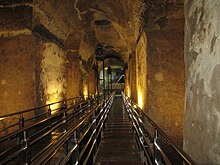| El Depósito | |
|---|---|
 A government building at the filter-beds of El Depósito A government building at the filter-beds of El Depósito | |
| General information | |
| Status | Completed |
| Location | Pinaglabanan Shrine |
| Town or city | San Juan, Metro Manila |
| Country | Philippines |
| Completed | 1882 |
| Closed | Unknown |
| Design and construction | |
| Architect(s) | Genaro Palacios |
El Depósito (lit: The Deposit) is an old underground water reservoir in the city of San Juan in Metro Manila, Philippines. It was built by the Spanish authorities in 1882 with a capacity of 15 million gallons to provide the residents of Manila and its surrounding areas with an adequate water supply. The reservoir was historically known as the site where the onset of the Philippine Revolution through the Battle of San Juan del Monte took place in 1896.

History
El Depósito was part of the Carriedo Waterworks, which was built from 1878 to 1882 under Genaro Palacios, a Spanish engineer and architect who also decided to use the Marikina River as El Depósito’s water source.
The underground reservoir held military strategic importance. During the Philippine Revolution, the Katipunan attempted to seize El Depósito from Spanish colonial authorities in the Battle of San Juan del Monte in 1896 and it was held by Filipinos during the Philippine-American War. It was used as an arsenal; first by the Americans during their colonial rule, then by Imperial Japanese forces as they occupied the Philippines in World War II. It also served as a pulmonary hospital housing tuberculosis patients and as a firing range. El Depósito was recaptured by Allied Forces in 1945, but it later fell to disuse after Philippine independence from the United States in 1946.
Efforts to rehabilitate the underground reservoir began in 2016, when the University of the Philippines Archaeological Studies program conducted assessment and excavation of the structure. The National Historical Commission of the Philippines cleaned El Depósito’s tunnel in 2018 in preparation for the development of the site as a tourist destination. The rehabilitated reservoir opened to the public on November 30, 2021.
Water Supply
When El Depósito still functioned as a water supply storage, it had a capacity of 56,000 cubic meters (2,000,000 cu ft) for 300,000 people. Ventilation shafts kept the water fresh and free from contamination. As part of the Carriedo Waterworks, the reservoir also supplied various hydrants and fountains in Manila.
From the main source of the Marikina River, water was pumped to the reservoir through a 5 kilometers (3.1 mi) length of cast iron pipes passing through the Santolan area. Situated below an elevated hill, the reservoir consists of a vast central channel connecting 25 smaller canals, each measuring 5 meters (16 ft) high and 3 meters (9.8 ft) wide.
Cultural Property

On August 30, 1972, a marker was installed by the National Historical Commission of the Philippines in recognition of El Depósito as a cultural property. In honour of the first battle of the Philippine Revolution, the land around El Depósito was converted into the Pinaglabanan Memorial Shrine and Park.
External links
- [REDACTED] Media related to El Deposito at Wikimedia Commons
References
- ^ "National Historical Commission of the Philippines official website". Pinaglabanan Memorial Shrine. Archived from the original on 2015-07-19. Retrieved 2015-04-20.
- Ingles, Raul Rafael (2008). 1908: The Way it Really was : Historical Journal for the UP Centennial, 1908-2008 (Illustrated ed.). UP Press. p. 297. ISBN 9789715425803.
- ^ Villafuerte, Din (2 March 2019). "Water runs deep at Museo El Deposito". Philippine Daily Inquirer. Retrieved 11 September 2019.
- Reysio-Cruz, Matthew; Santa Cruz, Maxine (8 July 2019). "Pinaglabanan Memorial Shrine gets P50-M makeover". Philippine Daily Inquirer. Retrieved 11 September 2019.
- ^ Reysio-Cruz, Matthew (9 September 2019). "El Deposito to be opened to public in 2020". Philippine Daily Inquirer. Retrieved 11 September 2019.
- Abuan, Alehia Therese (30 November 2021). "'Oldest' El Deposito Reservoir open to public". Philippine Information Agency. Retrieved 13 September 2023.
- Quadra-Balibay, Aurora. "Historical 19th century Manila underground reservoir "El Deposito" to reopen in 2020". Retrieved 17 September 2019.
- De Leon, Susan. "Metro Manila water system and the story of Museo El Deposito". Philippine Information Agency. Retrieved 11 September 2019.
- National Historical Institute (Philippines) (1993). Historical Markers: Metropolitan Manila. National Historical Institute (Philippines). p. 278. ISBN 9715380468.
Categories: